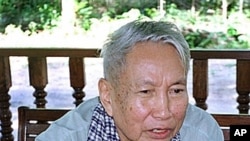It has been more than three decades since the Khmer Rouge began a violent campaign that laid waste to Cambodia, killing up to a quarter of the population in pursuit of a communist utopia. As the four most senior surviving Khmer Rouge leaders go on trial in Phnom Penh, the man most responsible, Pol Pot will never see justice. He died in 1998 just as the extremist communist group was disintegrating. But, one of the last strongholds of the Khmer Rouge, some Cambodians still consider Pol Pot a powerful figure to be worshipped.
Sek Navuoch kneels in front of a simple-looking grave covered by a tin roof and bordered by glass bottles that have been pushed upside down into the dirt.
The 32-year-old lights incense and presents bananas and then puts his hands together and prays.
Sek Navuoch says he prays at this grave a few times a year for peace of mind and prosperity with his business.
Ancestor worship is a tradition among Cambodia’s majority Khmer. But Sek is not praying to just any ancestor, he is prostrating to the infamous Khmer Rouge leader Pol Pot.
Under Pol Pot, known as “brother number one”, the communist extremists killed as many as two million Cambodians as they attempted to establish a peasant utopia.
Pol Pot’s spirit
Sek Navuoch says he prays here because he just respects him. He says he does not know if Pol Pot killed people or not. He says he was an old man and is now an ancestor, so he just prays to him for his family to be prosperous.
Pol Pot’s grave is just behind Sek’s small convenience store and he says he stumbled onto it after seeing Pol Pot’s relatives praying there.
He says business is good and, although he is not sure if it is due to Pol Pot’s spirit, he and his friends will continue to pray to him just in case.
Watch: Victim of Khmer Rouge gives tour of notorious prison
Un Reth is chief of Sleng Por village in Anlong Veng and a former Khmer Rouge soldier. He lost his left arm fighting for Pol Pot’s revolution.
He says Pol Pot was a great man for what he was able to accomplish but he failed to think of people’s suffering.
He says those who pray at Pol Pot’s grave are his close relatives or those who had close relations with him. He says they still believe in his policies. Some people even want to have his remains in their house, he says, because they think it will bring them good luck.
Like most former Khmer Rouge, Un Reth denies he was ever involved in any atrocities. But he says his colleagues, all of them now dead, admitted to him that they did torture and kill.
Ta Mok
The home of Khmer Rouge military leader Ta Mok overlooks a picturesque lake bursting with flowers.
The occasional canoe drifts by while cows graze near the cement and wood house, which has become a tourist site.
Pol Pot and the senior leaders now on trial held some of their final meetings here in the mid 1990s, before the Khmer Rouge split and then dissolved.
Seang Sokheng, head of the tourist office and himself a former Khmer Rouge, explains what happened.
He says the two groups loyal to Pol Pot and Ta Mok tried to control the Khmer Rouge army. At first Pol Pot was the most powerful man, he says, but later Ta Mok got the armies under his control so he became the most powerful.
Ta Mok took Pol Pot into custody and held a show trial. But the fallen leader died in captivity before he could face properly-constituted justice.
Ta Mok was arrested a year later and also died before trial.
The top four remaining senior political leaders were arrested in 2007 and are now facing charges ranging from torture to genocide at a United Nations-backed tribunal in Phnom Penh.
But they range in age from 79 to 85, and some observers are concerned that they may not live long enough to face the verdict for their role in Pol Pot's bloody revolution.
Photos by D. Schearf













